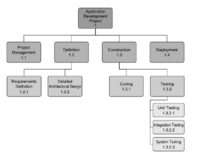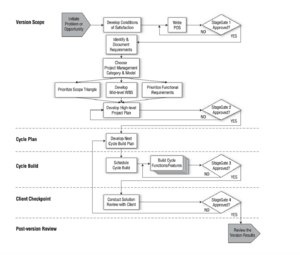Adaptive Project Framework
(→References) |
(→Limitations) |
||
| Line 60: | Line 60: | ||
===Focus on small teams=== | ===Focus on small teams=== | ||
| − | Because of the features of face-to-face informal communication and cooperation, agile methodologies concentrate on small teams. Face-to-face communication becomes especially difficult when a team are large, and more documentation is needed, which is a deviation from the agile spirit. Meanwhile, agile methodologies characterise teams according to the changing environment to be self-organising, which is mainly feasible for small teams and it does not work for larger teams, where more time is required to self-organise according to a change.<ref name=" | + | Because of the features of face-to-face informal communication and cooperation, agile methodologies concentrate on small teams. Face-to-face communication becomes especially difficult when a team are large, and more documentation is needed, which is a deviation from the agile spirit. Meanwhile, agile methodologies characterise teams according to the changing environment to be self-organising, which is mainly feasible for small teams and it does not work for larger teams, where more time is required to self-organise according to a change.<ref name="lim2"> |
===Adapting the framework=== | ===Adapting the framework=== | ||
Revision as of 19:13, 21 February 2021
Draft
Adaptive Project Framework (APF) is used in project management and is part of the group of agile methodologies. In so-called traditional project management, managers often approach investment projects as if surroundings and conditions behave in a stable way. However in modern society the volatility and the uncertainty need also to be taken into consideration in its business sector. Therefore traditional project management often does not work in new, difficult economy conditions, especially in software development. At the beginning of 21-century agile project management became widespread in science and practice. However solving the dilemmas of developing project with both agile and traditional project management became difficult and adaptive approach was invented to take advantage of and eliminating the disadvantages of both approaches mentioned above.[1] The goal of this article is to present background of Adaptive Project Framework, it's core values, how to apply the method, its limitation and then advantages and disadvantages of the approach.
Contents |
Overview
Recognised strategic leader in the field of project management, Robert K. Wysocki published the book Adaptive Project Framework in 2010, where he describes the APF approach when managing complexity in uncertainty. The AFP method was created to help teams adapt continuously to projects changing environment. This is a systematic and structured process that allows project managers to enhance their decisions and practices during the project life cycle based on learning from previous results achieved during the project. APF is designed to continually adapt to the changing situation of a project from its very beginning to its very end. Therefore, with this approach, nothing is fixed: neither the duration of the project, nor the budget, nor the risks, and everything can be continuously adjusted according to changes in the project's characteristics.[2]
To implement the APF methodology successfully, project teams must be willing to accept and adapt to changes. It is a costumer driven process, where the client is involved in every stage of the process and even given the opportunity to control the direction of the project. Consequently requires the project team to be effectively involved, acting with an open mind and trusting partnership.[3]
The APF project team is combined of client team and development team. Depending of the size of the project the client team can be a single person or multiple. In the client team there needs to be a single member in charge of the decision making, serving as a co-manager along with the development team leader. The development team is composed of technical professionals who are responsible for developing the project and producing the deliverables.[4]
A project scope is a variable from a traditional mindset and the general premise underlying an APF project is not to plan the future, the future is unknown. In APF, planning is done in each completed cycle, this is to maximise business value by adjusting the project scope of the solution and making the client a central figure. Giving the client the opportunity to be in charge of deciding what should be changed and what direction the project is heading. That means that an APF projects are constantly corrected to ensure maximum business value. When time or money or both have been used up, the deliverables will have the greatest business value that could have been generated from the collective knowledge and learning of the client team and the development team. [4]
Core Values
1. Client-focused: The most important value is that the client needs must always come first, As long as they are within the bounds of ethical business practices, the needs of the client must always come first.
2. Client-driven: Having the client to take on the project manager role and responsibilities, to give them the sense that they are determining the direction of the project and be meaningfully involved.
3. Incremental Results Early and Often: Deliverables are many and often, in an APF project, this gives the client an early delivery and is valuable when the question is what the client's real needs are. The functionality of the project's first cycles may be very limited but, in any case, useful.
4. Continuous Questioning and Introspection: This core value expresses to openness and honesty between the client team and the development team that must exist. Both sides must be committed to making the best possible business choices. Only with honest and open dialog can that occur.
5. Change Is Progress to a Better Solution: The Version Scope stage begins with the applicant and provider coming to a definition of what is needed and what will be delivered through the experience of the Conditions of Satisfaction (COS).
6. Don’t Speculate on the Future: APF strips out all work that is not value-added. Guessing only adds work back in with non-value-added. Leave it out when in doubt. APF is designed to spend the time and money of the client on business value defined by the client, not on non-value-added work.[4]
Application
Taking a closer look at the project framework, it is divided into five-phase strategy designed to provide clients with optimum business value from any cycle within the limits of time and cost constraints imposed by the client. Figure 2 shows a graphical portrait of the five phases, they consist of the project scope, the cycle plan, the cycle completion, the client checkpoint and finally post-version review. As mentioned before the APF is an iterative process and in each cycle you iterate within a cycle and also between cycles. In every cycle the development team and the client team come to a learning and discover potential opportunities to explore.[4]
Project Scope
As Shown in Figure 2, this is the defining phase and the planning phase that both contain approval points. The first phase of the process is identifying the project scope and that involves understanding the needs of the costumer. Therefore Stakeholders first step is to determine the Conditions of Satisfaction (CoS). That is the project goals and the desired outcome, by finding out what are the client's needs and how to meet those needs. From this point the Project Overview Statement (POS) is written to outline the CoS and is approved by all stakeholders, this is done to evaluate the effectiveness of the process and how it will be accomplished.[3]Finally three documents are needed to finish the project scope. First, there is the Functional Requirements, that prioritises actions as well as possible risks, challenges and assumptions. As the project progresses, this may change. Second, there is the Work Breakdown Structure (WBS) that enables teams to estimate costs, develop schedule and break down the processes into manageable parts that need to be accomplished. Finally there is the triangle scope, which is how time, cost and quality will converge.[5] In APF, planning is done within each cycle at the micro level. It starts with an RBS-based mid-level component or function, and ends with a WBS-based micro-level activity and task. Think of this as scheduling just-in-time. If each cycle involves work that takes only a few weeks to complete,
Cycle plan
Second phase of the method is the cycle plan, once the POS has been written and an prioritised list of known functionalities that both the client and project manager agree on, that is needed to solve the business problem. A high-level planning is done to priorities the functions into multiple cycles with timeframe to be developed. A typical cycle length is around two to six week long and before each cycle the length is documented and agreed with parties along with expectations. The project is divided into multiple mini-projects or cycles, where each cycle delivers one or more deliverables. This is the iterative part of the method, that is repeated over and over again for the next three steps. The cycle plan involves defining each task that needs to be accomplished in each project cycle according to the WBS but is adapted between cycles. Order of the tasks is established, their interdependencies are identified and assigned to employees with an given deadline.[2]
Cycle completion
The cycle work begins and is monitored throughout the cycle, it can be changed as the development team work on the project. The cycle finishes when the pre-defined time elapses, and all the tasks that were not done during this cycle are reconsidered and reprioritised if they were to move to the next cycle.Every team member has daily tasks and need to post updates at the completion of each day. This allows variances to be caught at an early stage and corrective action is taken into plan. Ensuring consistent contact, noting any demands for change and new ideas for improvement is critical. They should also be discussed in the next cycle when the team encounters some problematic situations.[3]
Client checkpoint
The Client review is an important step of the process, the client team and the development team come together and review the accomplished deliverables during this cycle and evaluate the quality of the features functionality produced. Together with the project manager a plan will be conducted on any corrections or improvements to be made for the next cycle. Once the review is done then the sequence Cycle Plan → Cycle Build → Client Checkpoint are iterated until the project is complete or until the time and budget has been exhausted.[5]
Post-version review
Completion of the project, the project manager, client and the team will come to together and evaluate the success of the project and determine whether project goals have been accomplished and that the client is pleased. There are three important questions that need to be answered:
1. Was the expected business outcome realised?
2. What was learned that can be used to improve the solution?
3. What was learned that can be used to improve the effectiveness of APF?
Then document of the whole process is done to reflect the effectiveness of the method, lesson learned and possible improvements for future projects.[4]
Limitations
Focus on small teams
Because of the features of face-to-face informal communication and cooperation, agile methodologies concentrate on small teams. Face-to-face communication becomes especially difficult when a team are large, and more documentation is needed, which is a deviation from the agile spirit. Meanwhile, agile methodologies characterise teams according to the changing environment to be self-organising, which is mainly feasible for small teams and it does not work for larger teams, where more time is required to self-organise according to a change.Cite error: Closing </ref> missing for <ref> tag
</references>
Cite error:
<ref> tags exist, but no <references/> tag was found

